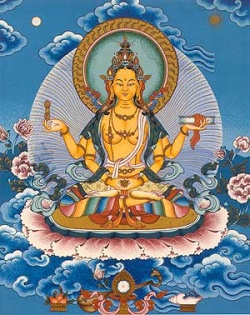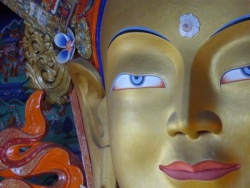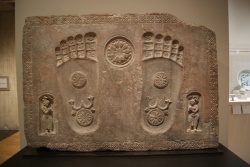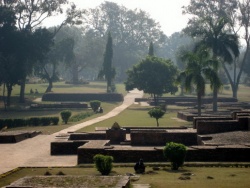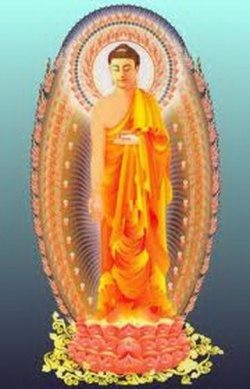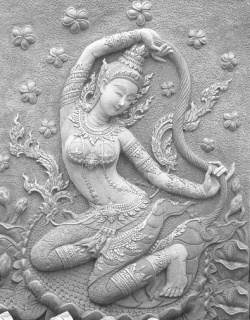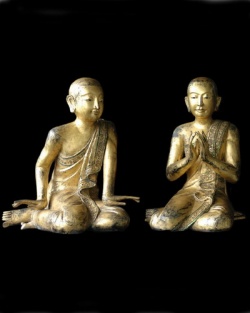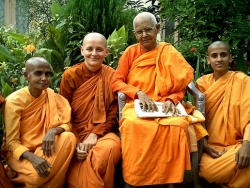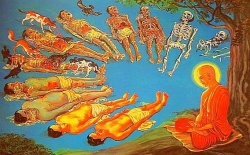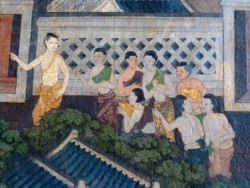A General Survey of Noble Persons (ariya puggala) in Relation to their Elimination of Fetters (saṃyojana)
By Bhikkhu Nyanabodhi (sajal barua)
01. Introduction:
Noble persons are those that have gone beyond the status of common worldlings (puthujjana) or unworthy ones (anariya). Common wordlings are recognized as those who dwell in any of the two extremes (dve anta), namely, self-mortification (attakilamathanuyogo) and self indulgence (kamesukhallikanuyogy). Noble ones are recognised as ones, having gone beyond the two extremes, practicing the middle path (majjhimapaṭipada), i.e., the noble eight-fold path with
the idea in mind to attain freedom from the samsāric suffering. Thus while journeying through the middle path the noble persons eliminate evil tendencies within, which are variously known as canker (āsava), defilement (kileśa), and fetter (saṃyojana) etc. As soon as they, having eliminated certain evil mentalities, enter into the noble-
family, they are designated as āryapuggala, ariyasaṃgha or ariyasāvaka. Though all in the noble family are called ariya puggala, they differ from each other in terms of their elimination of fetters (saṃyojana), spiritual practices, and
attainments. Thus different lists of noble persons such as aṭṭhapurisapuggala, satta-puggala etc. are found in the canon. In this paper I shall primarily focus on the enumeration of the noble persons with their elimination of fetters. For this matter I also shall discuss the limitation and problems of this enumeration (of noble persons) wherever necessary.
02. Noble Persons:
The four pairs (cattāri yugāni) of eight noble persons (aṭṭhapurisapuggala) are called ariya, and the remaining persons are non-ariya.[1] What are those four pairs of eight noble persons? They are: four persons identifiable with the path (magga) and four identifiable with the fruition (phala).[2] The eight noble persons are namely:
1) The one realizing the path of stream-winning (sotapattimagga)
2) „ „ „ „ fruition of „ „ (sotapattiphala)
3) „ „ „ „ path of once-return (sakadagamimagga)
4) „ „ „ „ fruition of „ „ (sakadagamiphala)
5) „ „ „ „ path of non-return (anagamimagga)
6) „ „ „ „ fruition of „ „ (anagamiphala)
7) „ „ „ „ path of holiness (arahattamagga)
8) „ „ „ „ fruition of „ (arahattaphala)
This is considered as the standard grouping of noble persons accepted by Theravāda Buddhist tradition. They are usually understood with reference to their gradual elimination of 10 fetters (dasa saṃyojana). In some places[3] in the canon the gotrabhū[4] is also listed as the 9th noble person. He is considered as the one who has transcended the world of non-ariya
and entered into the lineage of ariya. In the Puggala Paññatti the state of gotrabhū is defined with the following words – “he who is endowed with those things, immediately upon which follows the entrance into the noble path, this person is called a ‘Matured One’.”[5] The state of gotrabhū is made clearer in the commentary to this passage of Puggala Paññatti. It says; “he, who
through perceiving nibbāna leaves behind the whole multitude of worldlings, the family of worldlings, the circle of worldlings, the designation of worldlings and enters into the multitude of the noble ones, the circle of the noble ones, &
obtains the designation of noble one, such being is called a matured one.”[6] Venerable Nyanatiloka says; “it is the lightening like transitional stage between the state of wordling and that of sotapanna, immediately after which one enters into the magga of sotapanna and thus he is called the 9th ariya puggala”.[7]
The 8 noble persons are summed up into 4 individuals consisting of those obtaining the fruition (phala) only. As it is mentioned above their states as noble persons are understood in relation to their gradual elimination of 10 fetters. This is clearly shown in the following table:
10 fetters sotapatti sakadagami anagami arahant
sakkayadiṭṭhi no no no no
Vicikiccha no no no no
sīlabbataparamāsa no no no no
Kāmarāga yes weaken no no
Vyapāda yes weaken no no
Rūparāga yes yes yes no
Arūparāga yes yes yes no
Māna yes yes yes no
uddhacca/
bhavapaṭilabhika
yes yes yes no
Avijjā yes yes yes no
Table-01
However, this understanding of noble persons in relation to their abandonment of fetters is found dubious when looked at the stereotype passages in the canon and other groupings of noble persons[8]. I shall discuss the stereotype passages that challenge the traditionally accepted exposition of noble persons and fetters in the subsequent paragraphs of this essay, but for now I
shall focus on at least one example of different grouping of noble persons found in the canon. In this regard the one that comes almost immediately next to the grouping of eight noble persons is the grouping of seven noble persons (sattapuggala). The seven noble persons are namely: both ways liberated one (ubhatobhāgavimutta), one liberated through wisdom
(paññāvimutta), body-witness (kāyasakkhi), vision attained (diṭṭhippatta), one liberated by faith (saddhavimutta), follower of dhamma (dhammānusārī), and follower of faith (saddhānusārī). It should be mentioned here that though there are different groupings of noble persons found in the canon; the grouping of eight noble persons became the yardstick
based on which other noble persons are judged. In other word the status of seven noble persons are judged and understood depending on the position of eight noble persons. The following chart makes it clearer.
8 stages
7 NBP[9]
sotapatti
magga/phala
sakadagami
magga/phala
anagami
magga/phala
arahatta
magga/phala
Ubhatobhāgavimutta
Paññāvimutta
Kāyasakkhi
diṭṭhippatta
saddhavimutta ([10])
Dhammanusari
Saddhammanusari
Table-02
In this chart, ubhatobhāgavimutta and paññāvimutta are found in the state of arahant-hood, kāyasakkhi is in 7 stages beginning from sotapattimagga up until arahattamagga, diṭṭhippatta is in 6 stages in between the sotapattimagga and
arahattaphala, saddhavimutta is in 7 stages beginning from sotapattiphala until arahattaphala, and the last two i.e. dhammānusārī and saddhānusārī are in the stage of sotapattimagga. Thus it is clear from the above explanation that noble persons although differently categorised according to their practices and attainments are to be understood in relation to the eight
supramundane consciousnesses (lokuttara citta). According to the abhidhammik explanation the eight consciousnesses are divided into two categories, each containing four, in terms of their functions. The four magga-s are called supramundane wholesome consciousnesses (lokuttarakusalacittāni) and the four phala-s are called supramundane resultant consciousnesses
(lokuttaravipākacittāni). They are called supramundane because they arise in the process of transcending (uttara) the world (loka) consisting of five aggregates of clinging. Consciousness in each of the magga/s is said to endure only for one
thought moment whereas in the phala-s it endures more than just one thought moment. And therefore, the four phala-s are understood as real states of spiritual experience which we shall be dealing with as we go along.
02.01.Stream enterer (sotapanna):
A stream-enterer is the lowest of the four noble persons. He eliminates 3 fetters, namely personality belief, sceptical doubt, and attachment to rites and rituals. The stereotype passage defining this noble person runs thus:
“After the disappearance of three fetters, the monk has won the stream to nibbāna and is no more subject to rebirth in lower worlds, is firmly established, destined for all enlightenment.”
Texts[11] speak of three types of stream-enterer, namely, the one ‘with seven rebirth at the utmost’ (sattakkhattu-parama), the one ‘passing from one noble family to another’ (kolankola), and the one ‘germinating only once more’ (eka-bījī). All three
types of noble persons, having eliminating three fetters, enter into the stream (to nibbāna) and are no more subject to rebirth in lower realms.[12] They are destined to attain the full enlightenment. The differences among them lie in terms of how many rebirths they are taking until they reach the final attainment.
It should, however, be mentioned here that according to the Abhidhammatthasangaha a stream-enterer even eliminate greed, hatred and delusion which are usually understood as attenuated by an once-returner. The text says;
“…it further cuts off all greed, hatred and delusion strong enough to lead to a sub-human rebirth….”[13]
This point is not compatible with the traditional exposition of stream enterer. Nevertheless, it bears some significance as to greed, hatred and delusion are explained as unwholesome roots (akusalamūla) which are to be got rid off if anybody desires to achieve the supreme bliss (paramaṃ sukhaṃ) which is nibbāna. Thus it is logical to think that upon entering into the stream or rather into the family of noble persons one gradually becomes free from these evil mental states.
02.02.Once returner (sakadagami):
Once-returner is a person, who, according to the generally accepted definition, not only has eliminated three fetters as in the case of the stream enterer, but also has attenuated two subsequent fetters, namely, sensuous craving and ill-will.[14] But there is a mention of one more fetter in the stereotype passage which runs as follows:
“After the disappearance of three fetters, and reduction of greed, hatred and delusion, he will return to this world only once more; and having once more returned to this world, he will put an end to suffering.”
According to this passage an once-returner, after eliminating three fetters, attenuates greed and hatred which could be understood as sensuous desire, and ill-will respectively as they appear in the list of 10 fetters. He also attenuates delusion
which corresponds to ignorance (avijja) the last and the tenth fetter and should be abandoned only by one attaining arahant-ship. It suggests that an once-returner, non-returner and even a stream enterer gradually attenuate not only delusion or ignorance but also other higher fetters, and thus it questions the validity the traditional explanation of noble persons and
fetters. Interestingly enough, as we have seen earlier, a stream enterer is explained in the Abhidhammattasanghaha not as one attenuating the greed, hatred and delusion but as one eliminating them totally. And an once-returner is explained, in the same text, as one attenuating the grosser form of sensual desire and ill-will. However, this point requires further clarification.
02.03.Non-returner (anāgami):
Anagami is the third recluse who eliminates five lower fetters (orambhagiya saṃyojana). The stereotype passage explaining an anagami runs as follows:
“After the disappearance of five fetters he appears in a higher world, and there he reaches nibbāna without ever returning from that world (to the sensuous sphere).”
However, this explanation regarding the non-returner is problematic for it does not consider different types of other non-returners found in the canon. Two lists of non-returners that are found in the Aṇguttara nikāya are – one with five and the other with seven individuals. Surprisingly, in both cases the non-returners are discussed not in relation to fetters, but in terms of their spiritual progress and with similes. The list of non-returners with five individuals consists of;
1) One who dies and attains nibbāna before half the age he should have lived in a Brahma world expires (antaraparinibbayin)[15]
2) The term-curtailing passer away (upahacca-parinibbayin)
3) The automatic passer away (asankhāra-parinibbayin)
4) The Passer away after strenuous exertions (sasnkhāra-parininibbayin) and
5) The stream ascending Akaṇiṭṭha traveller (uddhaṇsota-akaniṭṭha)
The question that arises with regard to these five non-returners is whether all of them eliminate five lower fetters (orambhāgiya saṃyojana) as it is held from traditional viewpoint or how do they differ from each other. In the canon sometimes non-returners are distinguished from arahant/s in terms of their level of perfection of five spiritual faculties (pañcabala).
Of the two the latter is said to be perfected while the former is not in these five spiritual faculties.[16] Non-returners are also explained as perfected in both morality and concentration, but not in wisdom and thus they are in a lower position in the Buddhist spiritual journey comparing to those of arahant/s.
Aṇguttara Nikāya mentions of three fetters, namely,
(1) orambhāghiya saṃyojana,
(2) uppattipaṭilābhika saṃyojana, and
(3) bhavapaṭilābhika saṃyojana.
The first refers to the five lower fetters that tie an individual to the lower realms, second and third refer to the five higher fetters that tie an individual to the higher realms, i.e. form and formless realms. According to the traditional explanation, a non-returner eliminates only the orambhāgiya saṃyojana and an arahant eliminates all of the three fetters.
However, there is a passage in the Aṇguttara Nikāya which enumerates arahant and the five non-returners in relation to their perfection of morality, concentration and wisdom
and elimination of fetters
. The passage runs thus:
“the person who trains himself in perfecting morality
, concentration and wisdom is able to accomplish, with the destruction of all cankers, the freedom which is concentration
, the freedom which is insight here and now within this life. if he fails to do so, with destruction of the five lower fetters, he will be an antarāparinibbāyin
, if he fails to be so, he will be an upahaccaparinibbāyin, if he fails to be so, he will be an asaṇkhāraparinibbāyin, if he fails to be so, he will be an sasaṇkhāraparinibbāyin, if he fails to be so, he will be an uddhaṃsota-akaniṭṭha
, a person who is in the upper stream, heading towards Akaniṭṭha
”[17]
In this passage we see following three features, namely;
(1) one becomes an ubhatobhāgavimutto
arahant
by perfecting three spiritual
training and eliminating all fetters
.
(2) having failed to do so, one becomes an antarāparinibbāyin
by eliminating five lower fetters
.
(3) the subsequent four non-returners
are those who have eliminated five lower fetters
and each is lower than the former one probably in their understanding of reality
.
But as we shall see later an antarāparinibbāyin eliminates seven fetters and even the last of the five non-returners, i.e. the uddhaṃsota-akaniṭṭha eliminates five lower fetters
. The other three in between them probably differ in their attenuation of five higher fetters
. Let us see the following table.
The above table shows that among the 5 antaraparinibbayin has only the fetter of existence which, as Prof. G. A. Somaratane suggests[1], would actually be the ninth fetter, if we may say, replacing the fetter of restlessness from the traditional list
of ten fetters. It should also logically include the fetter of pride and ignorance in its scope for they do not come under the fetter of rebirth which an uddhansota-akaniṭṭha possesses together with the fetter of becoming under which come the
fetter of desire for form and formless. Another reason that supports the inclusion of pride and ignorance in the fetter of existence is that they can not come under the fetter of rebirth because an antaraparinibbayin does not possess it, but he possesses the former. Even though he possesses pride, existence-fetter and ignorance, he probably
already at the advanced level when he dies as a non-returner, and those fetters in him are too weak to lead him to another existence. He is explained in the Anguttanikāya[2] comparing with the “iron slab, heated ad beaten all day, a bit may come off[3] [fly up[4] and before touching the ground[5]] and cool down”. On the contrary the other four non-returners attain arahant-ship after being born in another existence.
02.01.Worthy one (arahant):
Arahant is the last and highest among the noble persons. He is the one who has eliminated all ten fetters and thus has achieved the goal of religious life. According to I.B. Horner; “an Arahant is a finished product (of the entire Buddhist spiritual path), one who has crossed over the flood and gone beyond (pāragata)”.[6] The term ‘Arahant’ is a combination of two
words namely, ‘ari’ (enemy) and ‘han’ (to kill or destroy). Therefore, Arahant means the one who has killed or destroyed his enemy namely passion (lobha), anger (dosa), and delusion (moha). He is said to have done what should be done and
therefore nothing left for him to do. Thus he is known as trained (asekha) as opposed to the other seven noble persons who are known as trainee (sekha) for they still have work left to do. The stereotype passage defining an arahant runs as follows;
“through the extinction of all cankers (āsavakkhaya) he reaches already in this very life the deliverance of mind, the deliverance through wisdom, which is free from cankers, and which he himself has understood and realized.”
What is clear from the above passage is that the arahant is defined not as one who has eliminated the fetters but as one who having destroyed the cankers became cankerless (āsavānaṃkhayā anāsavaṃ). According to traditional viewpoint, a non-returner
becomes an arahant only after destroying the five higher fetters. But the stereotype passage defining arahant says that he becomes an arahant not by eliminating 5 higher fetters, but by vanishing cankers. Question that arises with regard to this problem is whether both the cankers and 5 higher fetters are same. In the exposition of cankers (āsava) – there are four, namely,
1) sensual pleasure (kāmāsava),
2) existence (bhavāsava),
3) speculative view (diṭṭḥāsava), and ignorance (avijjāsāva).
Both the cankers and fetters though differently put are said to be more or less the same.[7]
03. Conclusion:
From the foregoing discussion we now come to the conclusion that the traditional explanation of noble persons in relation to their elimination of fetters has some shortcomings. In fact, scholars are of the opinion that it was not the original idea of the
Buddha to present the fixed list of saṃyojana. Even in the list of ten saṃyojana-s, as it is seen, the ninth fetter i.e. the fetter of restlessness seems out of place which should actually be replaced by the existence-fetter says Prof. Dr. G. A. Somaratane. However, the traditional exposition of ten fetters in relation to the spiritual attainment of eight noble persons is not to be totally neglected.
Abbreviations:
Aṇgutta Nikāya = AN
Saṃyutta Nikāya = SN
Puggala Paññatti = Pug
Bibliography:
1. Karunaratne, Upali. Ariyapuggala in the Encyclopaedia of Buddhism-Vol. II, pp. 83-4, (ed.) G. P. Malalasekara, 1966.
2. Ñaṇamoli, Bhikkhu (trans.). The Path of Purification (Visuddhimagga) of Bhadantācariya Buddhaghosa, Kandy: BPS, 1991.
3. Bodhi, Bhikkhu (gen. ed.). A Comprehensive Manual of ([[[Abhidhamma]])] (Abhidhammatthasanghaha), Kandy: BPS, 1993.
4. Nyanatiloka. Buddhist Dictionary, Singapore: Singapore Buddhist Meditation Centre, 1991.
5. Somaratane, G. A. ‘Intermediate Existence and the Higher fetters in the Pali Nikāyas, in the ‘Journal of the Pāli Text Society’ (JPTS)-Vol. XXV, pp. 121-154, (eds.) O. VONHINÜBER & R. F. GOMBRICH, Oxford: PTS, 1999.
6. Horner, I.B. The Early Buddhist Theory of Man Perfected, London: Routledge & Kegan Paul Ltd, 1999.
[1] Somaratne, p. 144.
[2] AN IV, pp. 70-74.
[3] 1st antaraparinibbayin.
[4] 2nd antaraparinibbayin.
[5] 3rd antaraparinibbayin.
[6] Horner, I.B., p. 98.
[7] For more details, see Somaratne ( JPTS-XXV), p. 29.
[1] Pug, Ch-01 (21-22).
[2] Pug, Ch-08 (01).
[3] AN VIII, 10; IX 16 etc.
[4] The term gotrabhū is consisted of two words, gotra (clan or lineage) and bhū (to be or become), literally means “one who has entered into the lineage (of noble ones)”.
[5] Pug, Ch-01 (10).
[6] Nyanatiloka, p. 60.
[7] Ibid.
[8] AN V, 23 (dasapuggala); Pug Ch-09 (navapuggala) etc.
[9] NBP (=Noble Persons).
[10] Saddhavimutta is usually understood in 6 stages in between sotapattimagga and arahattaphala. Since there is no special term to designate him after becoming an arahant, he is called a saddhavimutta arahant.
[11] Pug, Ch-01 (37-39); AN. III, p. 87. etc.
[12] The sphere of Hell (niraya), Ghost (peta), Fighting gods (asura) and Animal (tiracchāna loka).
[13] Bodhi, Bhikkhu., p. 67.
[14] Ibid.
[15] In the list of seven non-returners the first one i.e. antaraparinibbayin is divided into three as 1st, 2nd and 3rd antarapanibbāyin.
[16] SN V, p. 201: Imesaṃ kho bhikkhave, pañcannaṃ indriyānaṃ samattā paripūrattā arahaṃ hoti. Tato mudutarehi antarā parinibbāyī hoti…upahacca parinibbāyī hoti…asaṅkhāra parinibbāyī hoti…sasaṅkhāra parinibbāyī hoti…uddhaṃsoto hoti akaniṭṭhagāmī.

